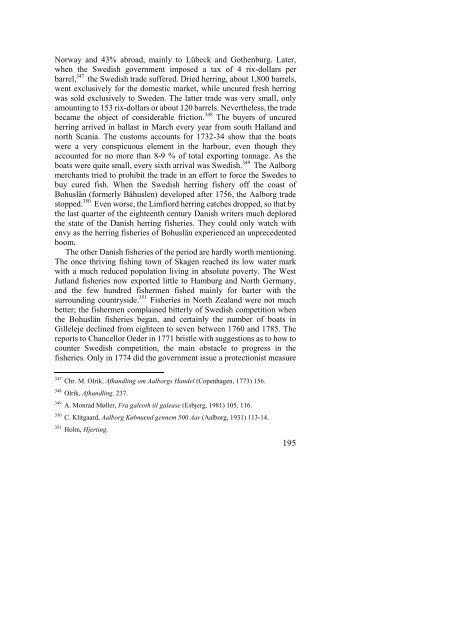The North Atlantic Fisheries, 1100-1976 - University of Hull
The North Atlantic Fisheries, 1100-1976 - University of Hull
The North Atlantic Fisheries, 1100-1976 - University of Hull
You also want an ePaper? Increase the reach of your titles
YUMPU automatically turns print PDFs into web optimized ePapers that Google loves.
Norway and 43% abroad, mainly to Lübeck and Gothenburg. Later,<br />
when the Swedish government imposed a tax <strong>of</strong> 4 rix-dollars per<br />
barrel, 347 the Swedish trade suffered. Dried herring, about 1,800 barrels,<br />
went exclusively for the domestic market, while uncured fresh herring<br />
was sold exclusively to Sweden. <strong>The</strong> latter trade was very small, only<br />
amounting to 153 rix-dollars or about 120 barrels. Nevertheless, the trade<br />
became the object <strong>of</strong> considerable friction. 348 <strong>The</strong> buyers <strong>of</strong> uncured<br />
herring arrived in ballast in March every year from south Halland and<br />
north Scania. <strong>The</strong> customs accounts for 1732-34 show that the boats<br />
were a very conspicuous element in the harbour, even though they<br />
accounted for no more than 8-9 % <strong>of</strong> total exporting tonnage. As the<br />
boats were quite small, every sixth arrival was Swedish. 349 <strong>The</strong> Aalborg<br />
merchants tried to prohibit the trade in an effort to force the Swedes to<br />
buy cured fish. When the Swedish herring fishery <strong>of</strong>f the coast <strong>of</strong><br />
Bohuslän (formerly Båhuslen) developed after 1756, the Aalborg trade<br />
stopped. 350 Even worse, the Limfiord herring catches dropped, so that by<br />
the last quarter <strong>of</strong> the eighteenth century Danish writers much deplored<br />
the state <strong>of</strong> the Danish herring fisheries. <strong>The</strong>y could only watch with<br />
envy as the herring fisheries <strong>of</strong> Bohuslän experienced an unprecedented<br />
boom.<br />
<strong>The</strong> other Danish fisheries <strong>of</strong> the period are hardly worth mentioning.<br />
<strong>The</strong> once thriving fishing town <strong>of</strong> Skagen reached its low water mark<br />
with a much reduced population living in absolute poverty. <strong>The</strong> West<br />
Jutland fisheries now exported little to Hamburg and <strong>North</strong> Germany,<br />
and the few hundred fishermen fished mainly for barter with the<br />
surrounding countryside. 351 <strong>Fisheries</strong> in <strong>North</strong> Zealand were not much<br />
better; the fishermen complained bitterly <strong>of</strong> Swedish competition when<br />
the Bohuslän fisheries began, and certainly the number <strong>of</strong> boats in<br />
Gilleleje declined from eighteen to seven between 1760 and 1785. <strong>The</strong><br />
reports to Chancellor Oeder in 1771 bristle with suggestions as to how to<br />
counter Swedish competition, the main obstacle to progress in the<br />
fisheries. Only in 1774 did the government issue a protectionist measure<br />
347 Chr. M. Olrik, Afhandling om Aalborgs Handel (Copenhagen, 1773) 156.<br />
348 Olrik, Afhandling, 237.<br />
349 A. Monrad Møller, Fra galeoth til galease (Esbjerg, 1981) 105, 116.<br />
350 C. Klitgaard, Aalborg Købmænd gennem 500 Aar (Aalborg, 1931) 113-14.<br />
351 Holm, Hjerting.<br />
195















